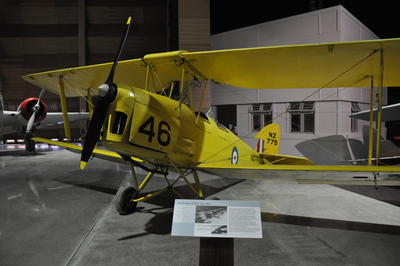Aircraft [de Havilland DH82A Tiger Moth (‘NZ775’)]
Maker and role
The de Havilland Aircraft Company Limited, Manufacturer
Production date
1940
See full details
Object detail
Accession number
1982.740
Production period
Description
DH82A Tiger Moth, painted yellow, is a single-engine, wire-braced biplane of composite construction fitted with a de Havilland Gipsy Major engine driving a fixed pitch propeller. It has a fixed 2-wheel main undercarriage and steerable tailskid. The aircraft is constructed mainly of wood, except for the fuselage which is steel tubing and plywood. The modern restoration covering is Ceconite, a Dacron and polyester fibre cloth. The fuselage is welded steel tubing forming rigid replaceable units comprising two engine bay side frames, 2 front fuselage side frames, cross members to join these and a single rear fuselage frame. The engine bay side frames are triangular and constructed of three 7/8 inch square section tubes welded flat. Power plant: 130 HP Gipsy Major engine. Accommodation: Tandem open cockpit sited under the upper wing. Dual control: 2 port and 2 starboard struts bracing the upper and lower wings.
Brief History
De Havilland DH 82A Tiger Moth NZ775/ZK-AIN
The Tiger Moth would be the most famous small aircraft in the world, and one of the most numerous. Production started in 1934, mainly for the Royal Air Force as a trainer, and for aero clubs. It was an ideal trainer and was the aircraft that most pilots used for their initial training, both in New Zealand and in Britain.
477 Tiger Moths were put into service in New Zealand between 1937 and 1956. This makes it the most employed aircraft type in New Zealand. Of those the Royal New Zealand Air Force operated 355, and at the end of World War II (1939-45) most of those went to aero clubs or topdressing operations.
The Tiger Moth you see here is painted in its yellow trainer colours as NZ775. It entered service with the No. 4 Elementary Training School at Whenuapai in October 1940. After 1942 the Whenuapai base was no longer used for training, and the aircraft was transferred to New Plymouth and later Ashburton. After the War it was bought by the Auckland Aero Club and re-registered as ZK-AIN. In 1952 it was sold to Barr Brothers for use as a topdresser, who later donated it to MOTAT.
Date: 1940
Manufacturer: Morris Motors, Cowley, Oxford, England (fuselage) & De Havilland, Rongotai, Wellington.
Type: Two-seat light training biplane
Wing span: 8.95 m
Length: 7.32 m
Engine: One 130HP Gipsy-Major 4-cylinder in-line air-cooled engine
Accommodation: Tandem open cockpits
The Tiger Moth would be the most famous small aircraft in the world, and one of the most numerous. Production started in 1934, mainly for the Royal Air Force as a trainer, and for aero clubs. It was an ideal trainer and was the aircraft that most pilots used for their initial training, both in New Zealand and in Britain.
477 Tiger Moths were put into service in New Zealand between 1937 and 1956. This makes it the most employed aircraft type in New Zealand. Of those the Royal New Zealand Air Force operated 355, and at the end of World War II (1939-45) most of those went to aero clubs or topdressing operations.
The Tiger Moth you see here is painted in its yellow trainer colours as NZ775. It entered service with the No. 4 Elementary Training School at Whenuapai in October 1940. After 1942 the Whenuapai base was no longer used for training, and the aircraft was transferred to New Plymouth and later Ashburton. After the War it was bought by the Auckland Aero Club and re-registered as ZK-AIN. In 1952 it was sold to Barr Brothers for use as a topdresser, who later donated it to MOTAT.
Date: 1940
Manufacturer: Morris Motors, Cowley, Oxford, England (fuselage) & De Havilland, Rongotai, Wellington.
Type: Two-seat light training biplane
Wing span: 8.95 m
Length: 7.32 m
Engine: One 130HP Gipsy-Major 4-cylinder in-line air-cooled engine
Accommodation: Tandem open cockpits
Marks
NZ775 Painted
46 Painted
46 Painted
Media/Materials
Credit Line
The de Havilland Aircraft Company Limited. 1940. Aircraft [de Havilland DH82A Tiger Moth (‘NZ775’)], 1982.740. The Museum of Transport and Technology (MOTAT).


Public comments
Kia ora Christine, thank you for sharing this information about your father flying this aircraft. What a nice connection to the object! We will follow up in email.
- MOTAT Curatorial Research posted one year ago.
My father John Hill flew this aircraft in three times in 1946: Entry from Dad’s log book for his first flying lesson: 7 Jun 1946 at 10.35 Pilot KBR (K B Robinson, Instructor Auckland, Aero Club), Machine type & no. DH2 (biplane) ZK AIN. Passenger was Self (John Hill). At 1500 feet for 30 minutes at Mangere. Instruct Straight & Level flight.
- Christine Barbour posted one year ago.